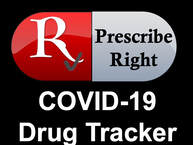|
Hydroxychloroquine and Chloroquine
A retrospective analysis of 96,032 patients from the proprietary Surgisphere multinational database of information from electronic health records, supply chain databases, and financial records compared patients that received chloroquine alone, chloroquine with a macrolide, hydroxychloroquine alone, or hydroxychloroquine with a macrolide to patients who received none of these treatments. The analysis found no benefit for chloroquine or hydroxychloroquine with or without a macrolide and the data suggested an increase in morbidity due to a higher incidence of arrhythmias. Due to the analysis of this trial, the WHO put a hold on the hydroxychloroquine arm of the trial for a safety review. The analysis was published in the journal Lancet. The Lancet editors issued an open letter to the authors of the analysis questioning the data integrity, highlighting flaws in the data aggregation and inadequate adjustment of confounders. They also pointed out the consequences of using a widely reported article on treatment decisions, clinical trials and public health policy. Information from the same database was used in an analysis of the safety of antihypertensive use in COVID-19 patients and published in the New England Journal of Medicine. The editors of NEJM published a similar letter of concern. After examining the concerns about the Lancet study, the WHO restarted the hydroxychloroquine arm of the study. Both NEJM and Lancet have asked to review the Surgisphere database and methods used to extract, store and retrieve data. In a response, Surgisphere has agreed to an independent academic audit to validate where the data comes from, the database, and the statistical analysis required for the two studies. Both the study published in Lancet and in NEJM have been retracted, because all authors of each article were not granted access to the full data set for either study. In a 14-day, 821 patient trial, prophylactic use of hydroxychloroquine did not reduce the incidence of infection compared to placebo (11.8% vs 14.3%) in healthy patients exposed to a known or suspected COVID-19 patient. An NEJM editorial points out inconsistent proof of exposure and confirmation of the development of infection. The prophylaxis regimen was initialed three days or later after exposure, which could have also decreased efficacy. COVID-19 Antibodies In a 28-day, 103 patient Chinese trial, treatment with convalescent plasma did not lead to a statistical difference in clinical improvement (discharge or reduction in severity) compared to placebo (51.9% vs 43.1%) in patients with severe or critical COVID-19 infection. An editorial in JAMA pointed out that patients with severe COVID-19 demonstrated clinical improvement (91.3% vs 68.2%) but not patients with critical infection (20.7% vs 24.1%). Anti-inflammatories and cytokine storm prevention CTI Biopharma is evaluating pacritinib for the treatment of severe COVID-19 in the 28-day, 358 patient, Phase III PRE-VENT trial. COVID-19 Vaccines Operation Warp Speed, a U.S. program designed to rapidly accelerate the development and availability of a vaccine for COVID-19, has chosen five vaccines they consider having the best chance to succeed. The vaccines chosen are being developed by Moderna (currently in Phase II), AstraZeneca (currently Phase II), Pfizer (currently in two Phase I/II trials) and vaccines in pre-clinical development from Johnson & Johnson and Merck. COVID-19 Resources The FDA has created a resource page of COVID-19 information for health care professionals. The page will be continuously updated and include information on emergency use authorizations, personal protective equipment, and medical products, including investigational drugs and fraudulent devices. Comments are closed.
|
Stay informed, subscribe to the Prescribe Right Pharmaceutical Pipeline Tracker
Archives
January 2023
Categories |
Services |
Company |
Support |
© COPYRIGHT 2015. ALL RIGHTS RESERVED.
|


 RSS Feed
RSS Feed